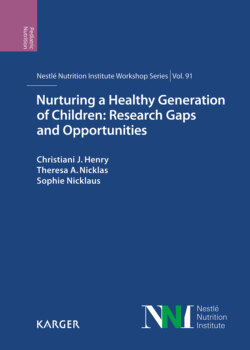Читать книгу Nurturing a Healthy Generation of Children: Research Gaps and Opportunities - Группа авторов - Страница 26
На сайте Литреса книга снята с продажи.
Introduction
ОглавлениеThe first smile, the first step, the first word… We never learn as much as in our earliest childhood, and: What children learn in their first 1,000 days characterizes them for the rest of their lives. This period is a sensitive one for the development of healthy eating habits, and, for this reason, interventions are likely to have a strong impact on health outcomes later during childhood and adulthood. Anyone setting the right course here lays the foundation for a healthy life. Be it growth, the immune system, or mental development, all benefit from a healthy diet.
The early development of taste and food pleasure plays an important role for children and has long-lasting influences on subsequent food preferences and choices [1, 2]. Eating a variety of foods is essential to achieve adequate coverage of macro- and micronutrients. However, children’s vegetable consumption often falls below current recommendations, highlighting the need to identify strategies that promote better acceptance of vegetables [3]. Apart from our innate liking for sweet foods and disliking for very bitter foods, sensory pleasure for foods is mostly acquired through our early eating experiences. Infants have a fine palate and more taste buds than adults when they are born. They have about 10,000 taste buds all around their tongue, including the roof, back, and sides of their mouth [4]. The flavors of what a mother eats while pregnant can reach the fetus and help set up flavor preferences later on [5, 6]. From birth, infants can taste and smell foods, an experience that can take place through human milk as the food eaten by the mother influences the flavor of her milk and, thereby, the child’s preference [7, 8]. Thus, preferences for specific flavors develop early through milk-related flavor exposure or even during pregnancy, allowing an easier acceptance of new flavors and textures. Breastfeeding favors the taste acquisition of a variety of foods [2, 9, 10]. This early experience serves as the foundation for the continuing development of food preferences across the lifespan and is shaped by the interplay of biological, social, and environmental factors.
At weaning, food preferences develop due to repeated exposure to a variety of foods, especially vegetables and fruits [10–13]. The persistence of these early influences seems to be long-lasting [1]. Factors favoring the development of food acceptance at the beginning of complementary feeding include, in particular, the role of early variety, repeated exposure, timing of food introduction, and sensory properties (texture, taste, and flavors).
With increasing age, the influence of a number of factors, such as peers, personal experience, family, and food availability, continue to mold food preferences and eating behaviors. During the 3rd year of life, most children enter a neophobic phase, during which the introduction of new foods becomes difficult [14]. However, habits of eating a variety of vegetables and foods acquired early in weaning appear to attenuate this neophobia [1].
